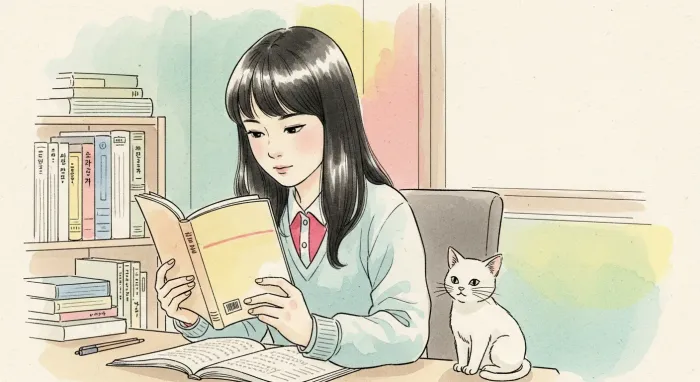Quiz: Sora and Nabi
Test your understanding of Korean vocabulary and grammar ('이다', '는') from the story 'Sora and Nabi'.

so-ra-wa 소라와 na-bi 나비
i 이 a-i-neun 아이는 so-ra-da. 소라다.
so-ra-neun 소라는 han-guk 한국 sa-ram-i-da. 사람이다.
so-ra-neun 소라는 hak-saeng-i-da. 학생이다.
so-ra 소라 yeop-e-neun 옆에는 go-yang-i-da. 고양이다.
go-yang-i 고양이 i-reum-eun 이름은 na-bi-da. 나비다.
na-bi-neun 나비는 so-ra-ui 소라의 go-yang-i-da. 고양이다.
na-bi-neun 나비는 ha-yan-saek 하얀색 go-yang-i-da. 고양이다.
a-ju 아주 jak-eun 작은 go-yang-i-da. 고양이다.
yeo-gi-neun 여기는 so-ra-ui 소라의 bang-i-da. 방이다.
jeo-geot-eun 저것은 chang-mun-i-da. 창문이다.
i-geot-eun 이것은 han-guk-eo 한국어 chaek-i-da. 책이다.
o-neul-eun 오늘은 jo-yong-han 조용한 o-hu-da. 오후다.
o-neul-eun 오늘은 mak-eun 맑은 nal-i-da. 날이다.
Test your understanding of Korean vocabulary and grammar ('이다', '는') from the story 'Sora and Nabi'.
In Korean to make a simple sentence like “I am a student”, you use the verb 이다 (ida). When the word before ends with a vowel, instead of 이다 it becomes 다 (da).
| English | Korean | Romanized |
|---|---|---|
| I am a girl | 나는 여자다 | na-neun yeoja-da |
| I am a student | 나는 학생이다 | na-neun haksaeng-ida |
이다 is the most basic form of “To be”. It is used often in factual writing and carries a neutral tone.
In speech, you will usually use one of the forms 이야 (informal), 이에요 (polite), or 입니다 (more polite).
In Korean, 은 (eun) and 는 (neun) are topic particles. They attach to the end of a noun to mark it as the topic of the sentence. The topic is what the sentence is about.
It can be useful to think of it as translating to “as for…”, although in reality it simply indicates the topic, a concept which doesn’t exist in English.
| English | Korean | Romanized |
|---|---|---|
| I (as for me) am a student. | 나는 학생이야. | na-neun hak-saeng-iya |
| The teacher (as for the teacher) is an adult. | 선생님은 어른이야. | seon-saeng-nim-eun eo-reun-iya |
은/는 helps set the context for the listener, letting them know what you are going to talk about. It can sometimes imply a contrast with something else, but its primary role is to introduce or highlight the topic.